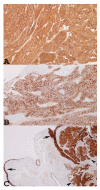The Role of Mesothelin Expression in Serous Ovarian Carcinoma: Impacts on Diagnosis, Prognosis, and Therapeutic Targets
- PMID: 35565412
- PMCID: PMC9103848
- DOI: 10.3390/cancers14092283
The Role of Mesothelin Expression in Serous Ovarian Carcinoma: Impacts on Diagnosis, Prognosis, and Therapeutic Targets
Abstract
Mesothelin (MSLN) is a protein expressed in the mesothelial cell lining of the pleura, peritoneum, and pericardium; its biological functions in normal cells are still unknown. Experimental studies using knockout mice have suggested that this molecule does not play an important role in development and reproduction. In contrast, it has been observed that this molecule is produced in abnormal amounts in several malignant neoplasms, such as mesotheliomas and pancreatic adenocarcinomas. Many molecular studies have also demonstrated that mesothelin is overexpressed in HSOCs. Here, we discuss the current knowledge of mesothelin and focus on its role in clinical and pathological diagnoses, as well as its impact on the prognosis of HSOC. Moreover, regarding the binding of MSLN to the ovarian cancer antigen CA125, which has been demonstrated in many studies, we also report on signal transduction pathways that may play an important role in the spread and neoplastic progression of this lethal neoplasm. Given that mesothelin is overexpressed in many solid tumours and has antigenic properties, this molecule could be considered an antigenic target for the treatment of many malignancies. Consequently, we also review the literature to report on mesothelin-targeting therapies for HSOC that have been recently investigated in many clinical studies.
Keywords: biomarker; mesothelin; mesothelin-targeting therapy; ovarian carcinoma.
Conflict of interest statement
The authors declare no conflict of interest.
Figures



Similar articles
-
The Impact of Mesothelin in the Ovarian Cancer Tumor Microenvironment.Cancers (Basel). 2018 Aug 21;10(9):277. doi: 10.3390/cancers10090277. Cancers (Basel). 2018. PMID: 30134520 Free PMC article. Review.
-
Clinical impacts of mesothelin expression in gastrointestinal carcinomas.World J Gastrointest Pathophysiol. 2016 May 15;7(2):218-22. doi: 10.4291/wjgp.v7.i2.218. World J Gastrointest Pathophysiol. 2016. PMID: 27190694 Free PMC article. Review.
-
Mesothelin as a Signal Pathways and Epigenetic Target in Cancer Therapy.Cancers (Basel). 2025 Mar 26;17(7):1118. doi: 10.3390/cancers17071118. Cancers (Basel). 2025. PMID: 40227616 Free PMC article. Review.
-
Free CA125 promotes ovarian cancer cell migration and tumor metastasis by binding Mesothelin to reduce DKK1 expression and activate the SGK3/FOXO3 pathway.Int J Biol Sci. 2021 Jan 14;17(2):574-588. doi: 10.7150/ijbs.52097. eCollection 2021. Int J Biol Sci. 2021. PMID: 33613114 Free PMC article.
-
Application of mesothelin immunostaining in tumor diagnosis.Am J Surg Pathol. 2003 Nov;27(11):1418-28. doi: 10.1097/00000478-200311000-00003. Am J Surg Pathol. 2003. PMID: 14576474
Cited by
-
Evaluation of the Potential Diagnostic Utility of the Determination of Selected Immunological and Molecular Parameters in Patients with Ovarian Cancer.Diagnostics (Basel). 2023 May 12;13(10):1714. doi: 10.3390/diagnostics13101714. Diagnostics (Basel). 2023. PMID: 37238197 Free PMC article. Review.
-
Ascites-Derived Organoids to Depict Platinum Resistance in Gynaecological Serous Carcinomas.Int J Mol Sci. 2023 Aug 25;24(17):13208. doi: 10.3390/ijms241713208. Int J Mol Sci. 2023. PMID: 37686015 Free PMC article.
-
Regulatory Mechanisms and Reversal of CD8+T Cell Exhaustion: A Literature Review.Biology (Basel). 2023 Apr 1;12(4):541. doi: 10.3390/biology12040541. Biology (Basel). 2023. PMID: 37106742 Free PMC article. Review.
-
Role of TIM-3 in ovarian cancer: the forsaken cop or a new noble.Front Immunol. 2024 Aug 13;15:1407403. doi: 10.3389/fimmu.2024.1407403. eCollection 2024. Front Immunol. 2024. PMID: 39206199 Free PMC article. Review.
-
The inhibitory receptors PD1, Tim3, and A2aR are highly expressed during mesoCAR T cell manufacturing in advanced human epithelial ovarian cancer.Cancer Cell Int. 2023 May 27;23(1):104. doi: 10.1186/s12935-023-02948-0. Cancer Cell Int. 2023. PMID: 37244991 Free PMC article.
References
Publication types
LinkOut - more resources
Full Text Sources
Research Materials
Miscellaneous

